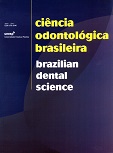Influência do tratamento de superfície na resistência adesiva
DOI:
https://doi.org/10.14295/bds.2006.v9i2.516Abstract
O objetivo deste trabalho foi avaliar in vitro a resistência adesiva de reparos em compósitos, utilizando diferentes tratamentos de superfície. Quarenta corpos de prova de resina composta (Filtek Supreme, 3M-Espe) foram envelhecidos artificialmente e divididos em quatro grupos (n=10): Grupo 1 (controle) - resina composta+ sistema adesivo + resina composta; Grupo 2 – resina composta + ranhuras com ponta diamantada grossa (nº 2135 – KG Sorensen) + sistema adesivo + resina composta; Grupo 3 - resina composta + orifícios com ponta diamantada grossa (nº 1031 – KG Sorensen) + sistema adesivo + resina composta; Grupo 4 - resina composta + jateamento com óxido de alumínio + sistema adesivo + resina composta. Após a realização dos tratamentos superficiais, foi aplicado o adesivo conforme as instruções do fabricante e confeccionado um cilindro de resina composta com auxílio de uma matriz de Teflon (2,1mm de diâmetro). Os corpos de prova foram submetidos a ciclagem térmica e em seguida armazenados por 24 horas a 37ºC. O teste de cisalhamento foi realizado na máquina Instron com velocidade de 1 mm/min. Os dados foram analisados por ANOVA e Tukey.(5%)Resultados: Os valores médios em MPa (±DP) foram: G1 - 14,7 (±5,0)B; G2 - 24,1 (±5,4)A; G3 - 15,61 (±3,24)B; G4 - 17,99 (±9,03)A,B. ANOVA mostrou diferença significante entre os grupos analisados (0,0059), apresentando o grupo 2 os maiores valores de resistência de união ao cisalhamento. Concluiu-se que as ranhuras realizadas como tratamento superficial em resina composta nanoparticulada aumentou a resistência de união ao cisalhamento.
Downloads
Downloads
Published
How to Cite
Issue
Section
License
Brazilian Dental Science uses the Creative Commons (CC-BY 4.0) license, thus preserving the integrity of articles in an open access environment. The journal allows the author to retain publishing rights without restrictions.
=================




























